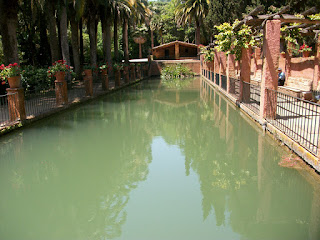 |
| Garden Bus |
For your delectation I've laid out in my ape level Spanish, a translation of their site introduction in
English below.
Pinya de Rosa Tropical botanical garden
The tropical botanical garden, Pinya de Rosa, is located in Costa Brava region between the towns of Lloret de Mar and Blanes. Set in 50 hectares, Pinya De Rosa covers all areas of the arts and the sciences.
Pinya de Rosa is the work of Fernando Riviere de Caralt*, Industrial Engineer, who had a great passion for gardening, and spent a great deal of his life (1945-1992) creating this place out of the natural landscape.
This tropical garden is made up of around 7000 species from different genera and is geared to showing particular collections as they live in their natural habitats.
Of particular note are the collections of Aloes, Agaves, Yuccas and members of the Opuntiaceae that are considered among the best in the world.
Thanks to the microclimate here (Median Temperatures 17-29 deg) the Succulents are accompanied by Draceneas, Palms and other wildflowers endemic to the local area. This garden is responsible for increasing the variety of cacti here and upon entry you can see ** Echinocactus Grusonii, Neobuxbaumia Polylopha and Echinopsis Pasacana.
Botanists*** have discovered and subsequently named several plants in honour of Senor Riviere, these include ****Leucostele Rivierei, Opuntia Rivieriana, Echinopsis Riviere de Caratii and Aloe Rivierei.
Its a privilege to know that many people from all over the world come here and we hope to maintain and expand Pinya De Rosa for all our visitors.
*Catalan Source, its all I could find. Though he seemed to be a member of the IOS reading between the lines.
** I've taken the liberty of updating the Carnegiea here to reflect its true name otherwise its correct.
*** Cardenas, Karl Backenberg, John Lavranos, Len Newton.
**** Bad news, all species described here are sunk with the exception of the Aloe. I haven't found the Opuntia, Leucostele is part of Echinopsis now and that species of Echinopsis is better known now as Echinopsis Oxygona.
The truth of the matter is this, it seems to be in decline. In the space of 5 years when we were there last the ponds at the bottom had gone (access was gone and we couldn't see the propagation areas at the base either). They still had a lot of cacti including some quite old stands of Neobuxbaumia and some Cleistocacti along with a lot of opuntias. There is drift planting of Lampranthus and a few varied species of Aloe and Agave as well as a Dasylirion or two.
I guess it was exceptional back in its day but clearly we are looking at the fall of Rome here and whatever splendour it had has long passed by.
I guess art means having your photo taken with a charming parrot as you go in, you can by photos or your face on a bowl as you go out. Apart from that I'll leave you with some photos we took there.
Some are from 5 years back.
 |
| Dasylirion |
 |
| Unknown Lampranthus |
 |
| Old Trunks |
 |
| Publicity Shot |
 |
| 13 Pool area. |
 |
| 13 Glass houses |

No comments:
Post a Comment